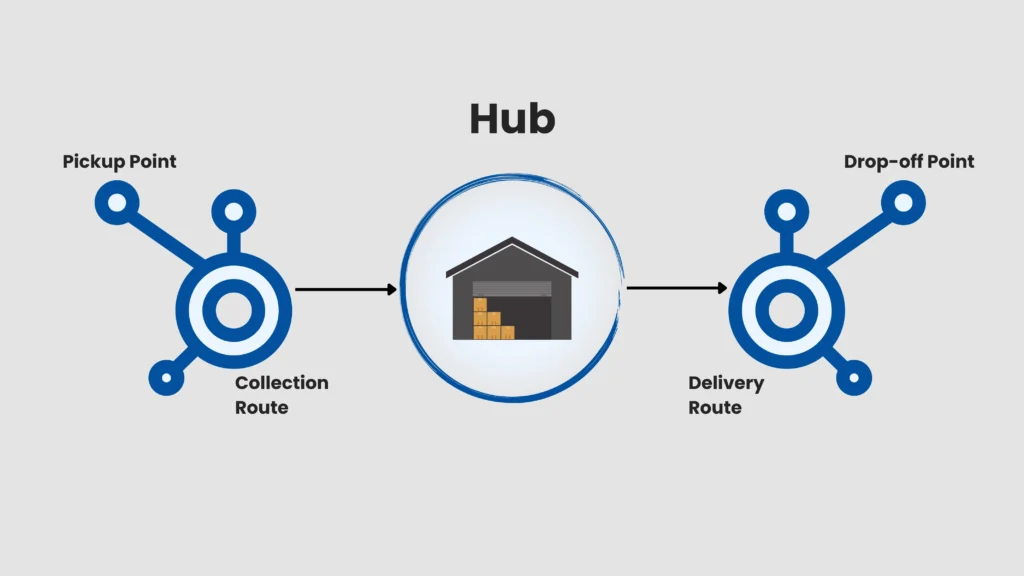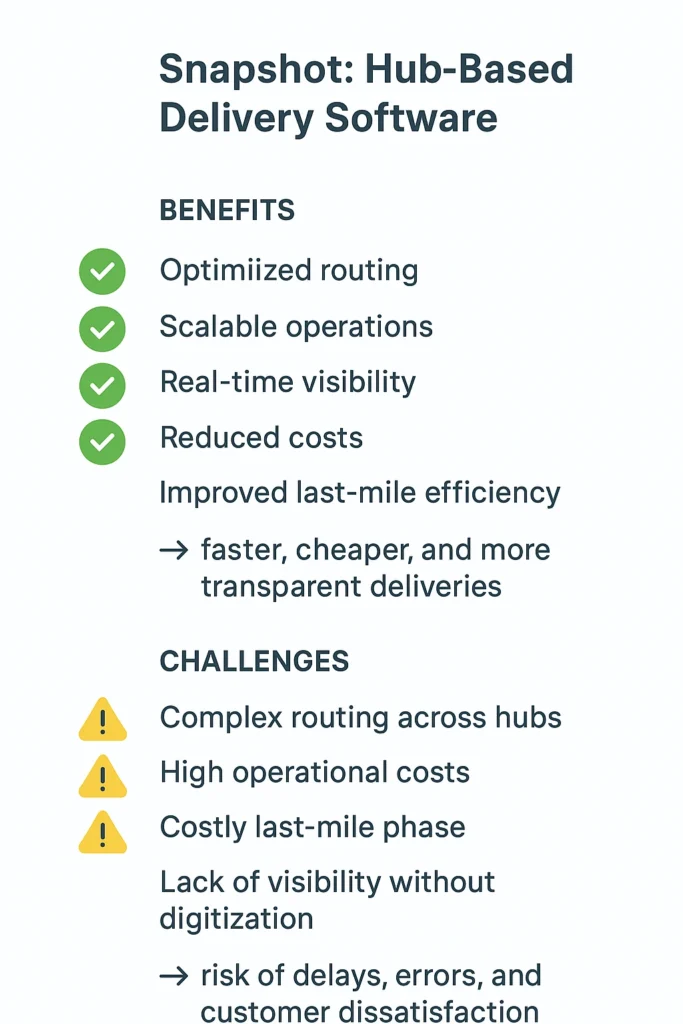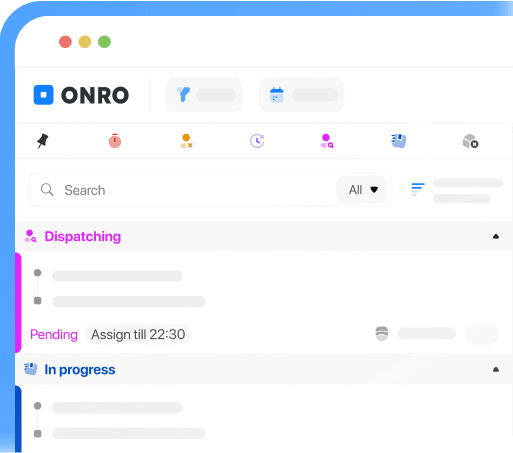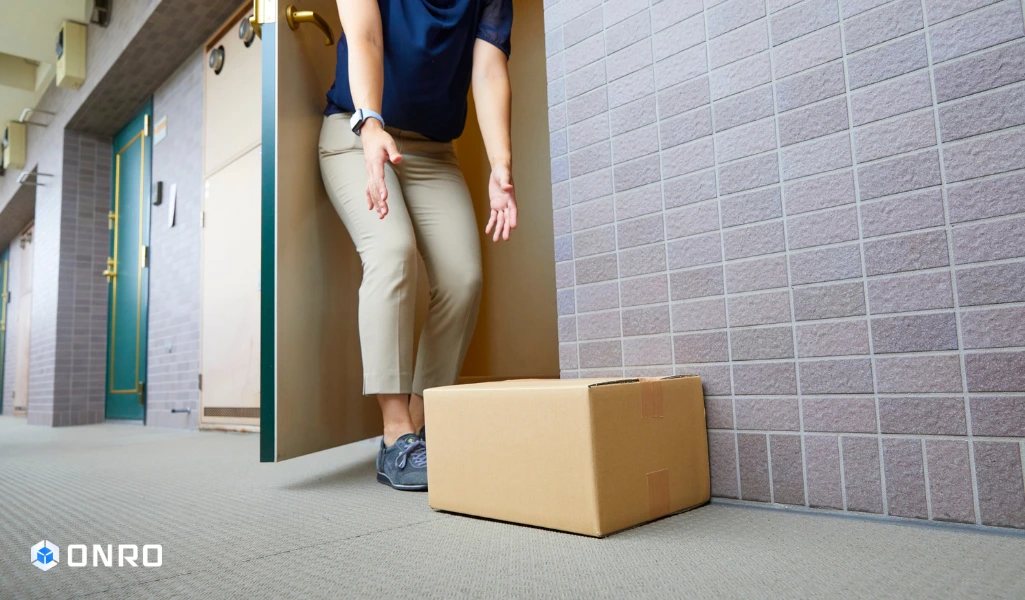Hub-based delivery software controls shipments in cargo using the mother-hub-and-spoke system for more efficient sighting and accuracy in deliveries from hubs to-and-fro between other hubs to another article destination.
Key Takeaways
-
Multi hub routing made easy with the AI-based optimization.
-
Last-mile delivery to ensure efficiency with real-time tracking.
-
Cloud deployment enables scalable operations across any number of foster locations.
-
Onro would integrate with ERP systems and other back-office systems.
-
Onro can integrate with parcel lockers to enable smart routing, interface branding, and real-time tracking.
-
Lowering cost, consumption of fuels, and delivery errors.
Increasing operational costs and a plethora of inefficiencies to be observed in last-mile delivery result in considerable shipment delays; hence, hub-based last mile delivery software provides the solution in route optimization, real-time driver tracking, and operation centralization. Learn how Onro’s advanced route optimization empowers hub-based delivery, cutting down costs while boosting the customer experience.
Try Onro for Free
Get your free access to the Onro All-in-one Last Mile Delivery Software.
What is Hub-and-Spoke Distribution Model?

Centralized warehouses, known as distribution centers, form the core of this logistics model. These hubs act as the center of the bicycle wheel, with spokes acting as delivery routes leading outward to different customer locations.
- Point-to-point: Cargo moves from one warehouse to the customer directly (A → B, C, D). It incurs inefficiencies and extra delivery costs. Simultaneously, the time for delivery elongates.
- Hub-based distribution: Deliveries are consolidated into hubs, from where they depart along spokes to their final destinations. It brings about lower costs and optimal travel distances alongside faster delivery.
Generally, this model is adopted for quick last-mile delivery fulfillment at lesser expenses by e-commerce, 3PL, FMCG, food, medical, and retail sectors.
How Hub-Based Delivery Software is Different from Standard Delivery Software
Direct delivery is generally for a point-to-point delivery system! It basically schedules, monitors, and signs-for deliveries but can’t cater to complexity with multiple hubs. Hence, a hub delivery software is required for the hub-and-spoke arrangement:
- Real-time data capture: Delivery data is electronically captured on the driver app and synchronized immediately, in real time, with the home office.
- Seamless integration: Well integrated into ERP systems and back-office and third-party systems for billing, reporting, and auditing activity.
- Centralization: Delivery from multiple hubs across locations and fleets must come through a single platform.
- Connectivity options: Supporting cellular networks from anywhere, and cloud-based implementation at any time.
- Operational Intelligence: GPS tracking, proof of pickup, proof of delivery, and barcode scanning ensure that deliveries are made accurately and in accordance with agreed terms.
In simple terms, the hub-based delivery software manages coordinating the hubs with the drivers and supporting the pickup-hub-delivery model that standard ones cannot fully do this.
Solutions and Challenges of Hub-based Delivery Software
In followings, we discuss the pros and also the challenges of hub-based delivery software the system deals with.

Benefits of Hub-Based Delivery Software
Improved Hub-to-Hub Routing
Optimized hub-to-hub and hub-to-destination routing enables hub-based delivery software to help logistics managers in minimizing the delays and saving an equal amount of fuel. Since trucks are GPS-fit, inefficiencies could be barred by the use of a real-time dashboard. And the very inefficiencies give way for re-routing.
Scalability Across Multiple Locations
Cloud and centralized controls open the door for new hubs with uninterrupted operations. Multi-location support will make scaling invisible, whether it’s from city to city or from one location to another within a city.
Enhanced Visibility and Accuracy
In terms of transparency, features such as shipment label, ePOD, and communication are included. Audit-logged data can be exported in CSV, and customers are notified immediately when order status changes.
Key Challenges in Hub-Based Delivery
Although the point-to-point system within the hub-and-spoke distribution model offers some delivery advantages, it also comes with several drawbacks, including:
Complex Routing with Multiple Hubs
Routing is among the toughest challenges when deliveries are shipped across different hubs. Each hub might get a different volume of deliveries, have a distinct time window for loading and unloading, and might accommodate drivers differently-would-be an incredibly complex scheduling process to handle manually within a specified period.
For one, delivery scheduling by agents or with spreadsheets may result in late deliveries, missed deadlines, and flaky fuel consumption. To avoid such occurrences, what companies really need are such delivery software that optimize routes while balancing loads across various delivery hubs, so that each truck departs with the most efficient plan possible.
High Operational Costs
Currently, the costs associated with facilities, labor, vehicles, and technology are very steep in managing multiple hubs. They become even more so if delivery information is handled manually by some people due to duplicated efforts, errors, loss of time, and so on. And the governance of such inefficient processes can offset the cost benefit coming out of centralized distribution.
Hub-based delivery software interfaced into businesses actually mitigates this through the automatic collection of data, minimizing the error base, and furnishing fleet operations. For example, Onro integrates with ERP and back-office systems to avoid data entry duplication and costly mistakes. Along similar lines, AI optimization matches demand to available capacity on hugely reduced kilometers to be driven and improves first-attempt delivery—thus saving fuel and labor costs.
Last-Mile Inefficiencies
The last-mile delivery is the most expensive phase of delivery with the charge sometimes going as big as 50% of the overall expenses in logistics. If optimization is not kept in account, it tends to further raise with the lack of the hubs’ coordination acts as headwinds on account of traffic load, failed delivery attempts, and long distances in between.
Onro software tries to work around a number of these inefficiencies with route optimization, real-time driver tracking, and automated dispatching. It ensures that drivers take the most fuel-efficient routes and that more deliveries are done on the first attempt, leading to lower client costs and faster deliveries as well as increased customer satisfaction.
Lack of Visibility
When overseeing several vehicles, hubs, and delivery partners, real-time tracking visibility quickly turns into a significant concern. Without digitization of systems, shipment tracking or driver monitoring becomes difficult for the business and, worse, maintaining records of deliveries is impossible. The absence of transparency results in missed deadlines, poor decision-making, and angry customers.
Therefore, hub-based delivery software addresses the most critical visibility issue in the delivery network. Some of the features that software offers are real-time driver tracking, centralized dashboards, and automated status updates. It assists in giving businesses follow-through on where the delivery is, which route has been taken, and when customers should expect their orders. Such transparency strengthens operational control while simultaneously earning customer trust.
Why Hub-Based Delivery Needs Optimization
Hub-based delivery works on shipments being consolidated at strategic hubs and then dispatched by one or two routes to the end customers. Hence, the kind of delivery would have, in principle, a higher degree of efficiency than point-to-point delivery, yet practically that would not be so because of operational factors that need proper intelligent optimization:
- Complex Routing: Multi-hub multi-stop payloads usually lead to poor routing. Onro’s route optimization automatically sequences orders so that the drivers take the shortest and most efficient route, thereby eliminating delays or unnecessary traveling.
- High Cost of Operations: Point inefficient routing increases cost in the form of fuel charges, labor charges, wear and tear of vehicles. Onro brings these costs down by sequencing deliveries from stop order, load delivery management, to route path optimization.
- Meeting Customer Expectations: Quick deliveries promised for the same-day or at least the very next day call for a great deal of planning. With Onro, be that rampaging courier actively informing the client of changes in order status in real-time, auto updates for late order deliveries, and digital proofs of delivery.
- No Visibility: Any tracking system, if pursued toward the drivers, route, or order processing-becomes inefficient if done merely manually. Onro extends the maximal domain of routing and order management with its courier dispatcher console featuring dash boarding, reporting, alerting, and full view of operations.
Ultimately, route planning, real-time data capture, and integrated management tools will make hub-based deliveries through Onro a faster, less costly, and completely transparent operation.
How Onro’s Route Optimization Powers Hub-Based Delivery
The Onro Route Optimization system has extended delivery farther from the hub than ever before by dynamically managing the orders, route assignments, and driver assignments to fast-track the pace of operations, thus enabling smarter and more reliable last-mile executions. Delivery efficiency and strengthening cost control measures are crucial in the hub-and-spoke logistics. Onro’s route optimization gives a modern twist to hub-based deliveries by dynamically managing orders, routes, and drivers to facilitate better and faster last-mile operations. This guide takes you all the way from actual route creation to delivery through the entire transformation procedure.
Core Features of Onro’s Route Optimization
| Feature | Benefits |
|---|---|
| Smart Route Optimization | Saves time and distance, adapts to changes |
| Driver Assignment | Fast, flexible driver and order management |
| Real-Time Tracking | Live visibility, better decisions, happy customers |
| Route Statuses | Clear workflow: Unassigned → Done |
1. Smart Route Optimization
Onro considers start points, destinations, traffic conditions, and priorities of delivery to try to minimize time spent traveling and to maximize efficiency. Last minute change needed? Feel free to resort to the stops yourself and give your drivers flexibility.
2. Easy Driver Assignment and Management
Assign drivers to a route just with a click or two. At any time throughout a driver’s status transitions from “Assigned” to “Started” and finally to “Done,” Onro allows the re-assignment of a driver or even the transfer of completed orders from one driver to another. Unassigned routes can just be left hanging befittingly while you search for a suitable driver.
3. Real-Time Tracking and Insights
Confidence, in the feedback, every step of the way. Onro tracks routes, stops, and order statuses with live updates and in real-time. Dispatchers get a very clear dashboard view on driver locations, progress, delivery completions, and much more. Customers stay informed through automated delivery notification systems and digital proofs of delivery.
4. Clear and Flexible Route Statuses
Onro offers a clear look into the status of a route:
- Unassigned: The route has been created yet a driver has not been assigned. Order statuses might be “Pickup Routed” or “Delivery Routed.”
- Assigned: Driver is assigned and ready to start the route. Orders are likely “Ready For Pickup” or “Ready For Delivery.” On occasion, orders can be in the status “For Return” or “Not Delivered“.
- Started: The driver started working on the route.
- Done: All orders have either been delivered or processed, and the stop has been concluded.
Try Onro for Free
Get your free access to the Onro All-in-one Last Mile Delivery Software.

Step-by-Step Guide: Using Onro Route Optimization for Hub-Based Delivery
Step1. Creating a New Route
An easy way to set up a delivery route using the Dispatcher Console is as follows:
- Go to Dispatcher → Routes → New.
- Enter all details for the route, such as the name, start date and time, starting hub location, and maybe the end location.
- Decide how loads will be loaded at the hub:
- No: Driver may start without scanning parcels.
- Optional: Driver may scan parcels or not.
- Force: Driver must scan all parcels at the hub before starting.
- Assign the driver right away or do not assign it yet; it shall be done later when multi-hub operations are considered.
Step 2. Adding Orders to a Route
Linking the appropriate orders onto the route is a must once the route is created:
The orders should be changed to any stage requiring the route No route, Ready for Pickup, Picked Up, Ready for Delivery, Out for Delivery, and Delivered.
Adding orders to an established route, or initiating one.
Step 3. Assigning and Changing Drivers
Due to hub-based delivery software, there is always some dynamic driver assignment going on:
- Drivers are assigned to Assigned, Started, or Done status routes.
- In case the driver change needs to be effected while the route is ongoing, then Onro automatically transfers to the new driver all order transactions completed so far by the previous driver, including those paid for by COD and the delivered orders, at the beginning of the new driver’s service on the route.
Step 4. Updating Route Status
Tracking of progress per hub may be carried out through route statuses.
- From Unassigned to Assigned/Started/Done: Orders on the route update their respective statuses automatically.
- From Assigned/Started/Done to the very same statuses: Changes before once Unassigned are not possible.
- Since status changes should be happening to all orders on the route, if there are some that cannot change, then the update must fail.
Route status helps track progress across hubs.
Step 5. Scanning Orders
With attention to accuracy and real-time visibility across hubs:
- Pickup: The driver would scan parcels once the pickup takes place, setting the status of the order to Picked Up.
- Loading at Hub/Warehouse: Scan all deliveries at the hub for loading from the list of parcels after sorting by the chosen load option before they can exit from the hub.
Step 6. Completing a Route
For the efficient final delivery:
- Driver app: Drivers should complete orders during the route and tap Complete Route.
- Dispatcher console: A route may be ended by setting status to Done.
- An ending report goes out for the managers about successful or failed deliveries, which serve as actionable insights to the management.
Step 7. Optimizing Routes
These are some of the efficient hub network route designs available in Onro:
- Orders are automatically arranged so that the hub can take the shortest and quickest route to the customers.
- A dispatcher can reorder stops if they want to give a particular delivery priority.
- ETAs to each stop update dynamically as the route progresses so that hubs, drivers, and customers will have real-time information.
Benefits of Onro Route Optimization for Hub-Based Delivery
| Challenge | How Onro Solves It |
|---|---|
| Multi-hub routing complexity | Dynamic route optimization and sequencing |
| High fuel and labor costs | Shortest-path routing and reduced idle time |
| Unpredictable traffic | Real-time route updates and reordering |
| Driver and order mismanagement | Integrated driver assignment, automatic transaction transfer, and status tracking |
| Customer visibility | Real-time tracking, ePOD, and notifications |
| Scaling operations | Cloud deployment supports multiple hubs and fleets seamlessly |
Best Practices for Maximizing Onro Efficiency
Following best practices will help the logistics manager derive the most benefits from using Onro’s delivery software:
1. Default Start Times for Routes Must Be Set
The start time on any given route is the time when an actual first pickup and delivery is allowed or, at least, on which basis an ETA can be calculated properly. Thus the start time should default to the shift time of the driver.
2. Enable Routes Tab for Driver App
Any special configurations should filter out routes not applicable to his/her type of work. Doing so will keep the driver from being confused so that he/she can focus on his/her daily tasks.
3. Keep Load Options under Review
Onro offers load options: do not scan, optional scan, or required scan. Depending on the will or restrictions, these options may be set. For example, to temporarily lessen manual errors, a force-scan option can be applied.
4. Minimize Manual Reordering as Much as Possible
Try and trust Onro’s internal optimizations to work well in most instances. Consider manual reordering only in extremely rare cases, such as when there are urgent deliveries or high-priority deliveries that simply cannot be arranged automatically. If these exceptions do occur, then manual reordering can be implemented.
FAQ I Hub-Based Delivery Software
The delivery software operates using the hub-and-spoke delivery method. The drivers do not get an assignment directly from the warehouse to an individual customer; rather, delivery consignments are routed via the hub. The software thus assists in planning between hub A and hub B, or between the hub and the destination, minimizing possible human error and offering real-time visibility throughout the entire delivery network.
Should route optimization be applied, the different deliveries between hubs and to final destinations would be planned in the most efficient way possible. By taking into account distance, traffic, delivery time windows, and capacity, the software helps cut fuel expenses, prevents late deliveries, and ensures timely and reliable delivery.
Warehouses managed by logistics companies can easily implement this software because hub-based delivery software reduces operational costs. Thus, it is scalable for multiple locations, enables real-time tracking-and-display, helping to spot routing inefficiencies, eliminate costly errors, and improve customer satisfaction.
Yes. Onro uses route optimization and real-time driver tracking to improve efficiency in last-mile delivery-the most expensive leg in logistics. Onro reduces the total kilometers driven in a given route, improving first-time delivery success and enhancing speed and accuracy.
Conclusion
Hub-based delivery software such as Onro, bringing route optimization in logistics, real-time tracking, and hub management. It works towards minimizing expenses for entities and contributes to final-mile deliveries and customer satisfaction. Do take a moment to schedule your Zero-Cost Demo of Onro Last Mile Delivery Software to reap the benefits.
Try Onro for Free
Get your free access to the Onro All-in-one Last Mile Delivery Software.


